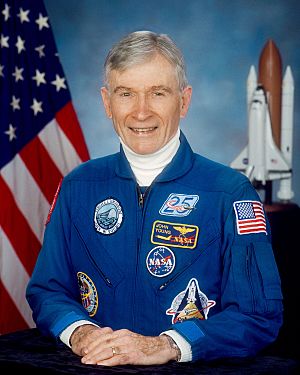John W. Young facts for kids
Quick facts for kids
John Young
|
|
|---|---|

John Young in 2002
|
|
| US Navy test pilot | |
| In office 1959–1962 |
|
| NASA astronaut | |
| In office 1962–2004 |
|
| Personal details | |
| Born |
John Watts Young
September 24, 1930 San Francisco, California, U.S. |
| Died | January 5, 2018 (aged 87) Houston, Texas, U.S. |
| Nationality | American |
| Alma mater | Georgia Institute of Technology, B.S. 1952 |
| Occupation | Naval Aviator, test pilot |
John Watts Young (September 24, 1930 – January 5, 2018) was an amazing American astronaut and naval officer. He was also a skilled test pilot and engineer. Young became the ninth person to walk on the Moon. This happened during the Apollo 16 mission in 1972. He also commanded the first-ever Space Shuttle mission, STS-1, in April 1981. John Young was the only person to pilot and command four different types of spacecraft. These included Gemini, the Apollo Command/Service Module, the Apollo Lunar Module, and the Space Shuttle.
Contents
Early Life and Training
John Young was born in San Francisco, California. He grew up with a passion for flight and exploration. He studied at the Georgia Institute of Technology. There, he earned a degree in aeronautical engineering in 1952.
After college, Young joined the United States Navy. He became a naval aviator and a test pilot. Test pilots fly new aircraft to see how they perform. This job helped him prepare for a career as an astronaut.
Becoming an Astronaut
In 1962, NASA selected John Young to become an astronaut. He was part of the second group of astronauts chosen. This group was known as "The New Nine." They joined the original Mercury Seven astronauts.
Young's first space flight was on Gemini 3 in 1965. He was the pilot alongside Gus Grissom. This was the first two-person American spaceflight. They completed three orbits around Earth.
He then commanded the Gemini 10 mission in 1966. On this flight, they performed two spacewalks. They also practiced linking up with another spacecraft. These missions helped NASA prepare for Moon landings.
Walking on the Moon: Apollo 16
John Young made history on April 21, 1972. He was the commander of the Apollo 16 mission. This mission was part of the Apollo program to explore the Moon. Young became the ninth person to walk on the Moon's surface.
During their time on the Moon, Young and Charlie Duke explored the Descartes Highlands. They drove the Lunar Roving Vehicle, a special Moon car. They collected over 200 pounds of Moon rocks and soil samples. These samples helped scientists learn more about the Moon.
The Apollo 16 mission lasted 11 days. It was a huge success for space exploration.
The Space Shuttle Era
After the Apollo program, John Young continued his work with NASA. He played a key role in developing the Space Shuttle program. The Space Shuttle was a reusable spacecraft.
On April 12, 1981, Young commanded STS-1. This was the very first flight of the Space Shuttle Columbia. It was the first time a winged spacecraft launched vertically and landed like an airplane. This mission proved the Space Shuttle could fly safely.
Young flew one more time on the Space Shuttle. He commanded STS-9 in 1983. This mission carried the first Spacelab module. Spacelab was a special laboratory for experiments in space.
Later Life and Legacy
John Young retired from NASA in 2004. He had been an astronaut for 42 years. This was the longest career of any astronaut. He flew six times into space, which was also a record at the time.
Young was known for his calm attitude and sharp mind. He helped make space travel safer and more common. He passed away on January 5, 2018, at the age of 87. John Young is remembered as one of the most experienced and important astronauts in history. His work helped us explore beyond Earth.

